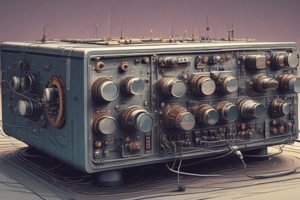Podcast
Questions and Answers
What is the primary reason for using a 4 to 20 milliamp current range for analog input instead of 0 to 20 milliamp?
What is the primary reason for using a 4 to 20 milliamp current range for analog input instead of 0 to 20 milliamp?
- It simplifies the conversion process from analog to digital signals.
- It allows for detection of faults like wire cuts or power outages. (correct)
- It provides a wider range of values for greater precision.
- It ensures compatibility with most sensors and analog input cards.
Which of these is NOT a component involved in the analog input process?
Which of these is NOT a component involved in the analog input process?
- Transmitter
- Analog to Digital Converter (ADC)
- Sensor
- Digital to Analog Converter (DAC) (correct)
What is the primary function of the transmitter in an analog input system?
What is the primary function of the transmitter in an analog input system?
- To amplify the electrical signal for better accuracy.
- To convert the measured physical quantity into an electrical signal. (correct)
- To filter out noise from the electrical signal.
- To convert the electrical signal into a digital format.
What is the purpose of the analog to digital converter (ADC) in the analog input process?
What is the purpose of the analog to digital converter (ADC) in the analog input process?
Why is it important to have an offset in the analog input range, such as starting at 4 milliamps instead of 0 milliamps?
Why is it important to have an offset in the analog input range, such as starting at 4 milliamps instead of 0 milliamps?
Which of the following is NOT a typical example of a sensor used in an analog input system?
Which of the following is NOT a typical example of a sensor used in an analog input system?
Flashcards are hidden until you start studying
Study Notes
Analog Inputs
- Analog inputs are more complex than digital inputs because they involve sampling a signal that changes over time, such as temperature or tank level.
- These signals are not simply 1 or 0, but rather a continuous range of values.
Measuring Real-World Phenomena
- Analog input devices convert physical world signals into a digital representation.
- Example: a level meter measures the height of a tank and transmits a value between 4 and 20 milliamp current.
Avoiding Errors with Offset
- When setting the measuring range, it's good practice to avoid starting from 0 milliamps to detect faults such as power outages or corrosion.
- This is because a faulty connection (e.g., a cut wire) would result in a 0 milliamp reading, but the tank level would not be at 0 feet.
- Instead, the "empty tank" measurement should be represented by a non-zero value, such as 4 milliamps.
Analog Input Components
- The sensor itself (e.g., flow sensor, level sensor, temperature sensor) contains a transmitter that sends a signal.
- The signal is transmitted as 4 to 20 milliamps.
- The analog input controller card samples the current and converts it to a digital value through an A-to-D (analog-to-digital) process.
Analog Inputs
- Analog inputs are more complex than digital inputs because they involve sampling a signal that changes over time, such as temperature or tank level.
- These signals are not simply 1 or 0, but rather a continuous range of values.
Measuring Real-World Phenomena
- Analog input devices convert physical world signals into a digital representation.
- Example: a level meter measures the height of a tank and transmits a value between 4 and 20 milliamp current.
Avoiding Errors with Offset
- When setting the measuring range, it's good practice to avoid starting from 0 milliamps to detect faults such as power outages or corrosion.
- This is because a faulty connection (e.g., a cut wire) would result in a 0 milliamp reading, but the tank level would not be at 0 feet.
- Instead, the "empty tank" measurement should be represented by a non-zero value, such as 4 milliamps.
Analog Input Components
- The sensor itself (e.g., flow sensor, level sensor, temperature sensor) contains a transmitter that sends a signal.
- The signal is transmitted as 4 to 20 milliamps.
- The analog input controller card samples the current and converts it to a digital value through an A-to-D (analog-to-digital) process.
Studying That Suits You
Use AI to generate personalized quizzes and flashcards to suit your learning preferences.




